Memories from Eva Rippy Pybrum
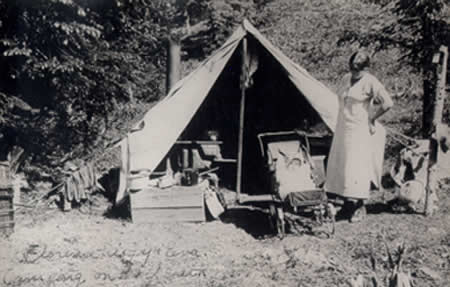 In
the year of 1916 while World War I was going on, Albert Einstein completed
his mathematical formulation of a general theory of relativity, which
includes gravity. Charlie Chaplin signed on with Mutual Studios and
earned an astronomical and unprecedented $10,000 a week, the cost
of a first-class postage stamp was $0.02 and on Thursday, March 2,
Eva Lorraine Rippy was born to John and Florence Rippy in Pagosa Springs,
Colorado. For a period of time when Eva was a baby, the family of
three lived in a tent on Wolf Creek Pass while her father worked for
the railroad. In
the year of 1916 while World War I was going on, Albert Einstein completed
his mathematical formulation of a general theory of relativity, which
includes gravity. Charlie Chaplin signed on with Mutual Studios and
earned an astronomical and unprecedented $10,000 a week, the cost
of a first-class postage stamp was $0.02 and on Thursday, March 2,
Eva Lorraine Rippy was born to John and Florence Rippy in Pagosa Springs,
Colorado. For a period of time when Eva was a baby, the family of
three lived in a tent on Wolf Creek Pass while her father worked for
the railroad.
Eva recalls:
When I was a baby, I had pneumonia. My parents had to walk a few miles
to get me to a doctor. He put a tiny bit of whiskey in my mouth to
help me breath. When I was four, I had Typhoid Fever. All my hair
came out when I had that. Between the Macht family and the Rippy family
I had a lot of relatives doting on me as the first grandchild in the
family. My brother, Leslie, was born in December of 1918. We lived
in a big house in Pagosa Springs then.
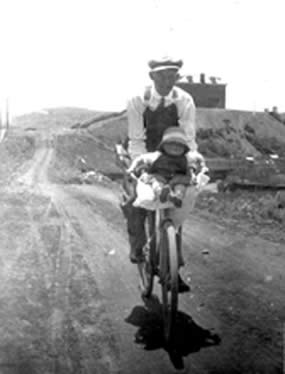 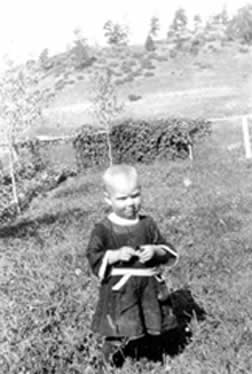
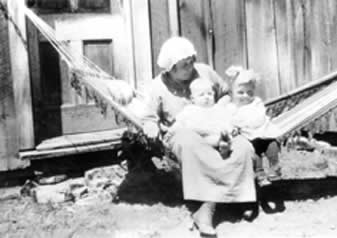
We moved when my father got a job with the D and RG Railroad in Chama,
New Mexico. It is there that my sister, Norma, was born. In 1926,
after Norma recovered from German measles, we left by train to travel
to California. We planned to join our relatives Clint and Bertha "Bobo"
Manchester who had moved to Corralitos. Bobo was my mother's youngest
sister.
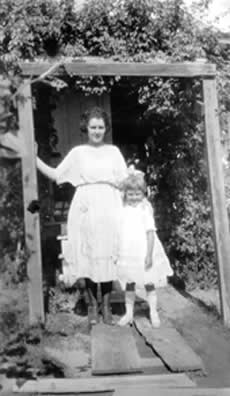
Eva with her Aunt Bobo
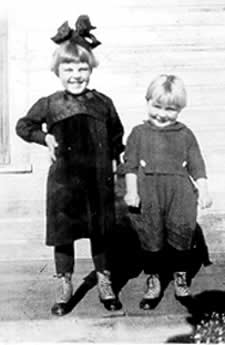
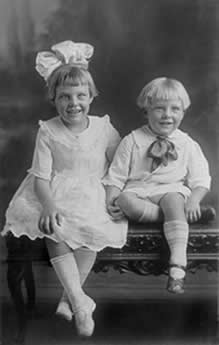
Eva and Leslie
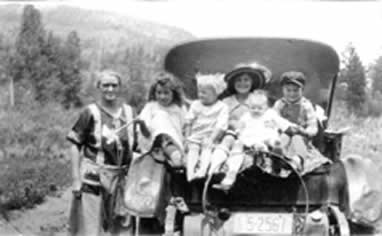
L to R: Gramma Emma, cousins Dorothy and
Margaret Diehl, Eva in hat holding baby Norma, and Leslie
For a short time, we lived in a house in Watsonville on Sudden Street
across from the playground (Callaghan Park today). My brother, my
little cousins, and I would take the waxy bread wrappers and put them
on the slide so we could go down faster. The lady in charge of the
playground would get mad at us because that was a "no-no".
We also took little bits of the tar that was used to seal the cracks
in the swimming pool so we could chew it. My grandmother, Emma Macht
Bayles, lived in a house at the top of the hill on Brennan Street.
I skated down that hill a couple of times.
 I
attended third grade there before we moved out to Corralitos. One
incident that stands out is when I took a graham cracker. The kids
who could pay a nickel got milk and graham crackers. I didn't have
money so I couldn't have them, but sometimes the teacher had me pass
out the crackers. One day, I put a cracker in my pocket to take home.
I was so ashamed of myself. My mother probably would have given me
money if I had asked. One other time, there was a rumor going around
town that the world was coming to an end on a certain date. When that
date arrived, I was so scared. I just knew it was going to happen.
I remember going out on the front porch in the evening to wait. I
woke up the next day, though, and we were still there. My mother bought
a magazine called "The Delineator." I couldn't wait for
it to come because it had paper dolls in it. I'd cut them out with
their little clothes and I'd play forever with them in my little world. I
attended third grade there before we moved out to Corralitos. One
incident that stands out is when I took a graham cracker. The kids
who could pay a nickel got milk and graham crackers. I didn't have
money so I couldn't have them, but sometimes the teacher had me pass
out the crackers. One day, I put a cracker in my pocket to take home.
I was so ashamed of myself. My mother probably would have given me
money if I had asked. One other time, there was a rumor going around
town that the world was coming to an end on a certain date. When that
date arrived, I was so scared. I just knew it was going to happen.
I remember going out on the front porch in the evening to wait. I
woke up the next day, though, and we were still there. My mother bought
a magazine called "The Delineator." I couldn't wait for
it to come because it had paper dolls in it. I'd cut them out with
their little clothes and I'd play forever with them in my little world.
When we moved to Corralitos, Bobo and Uncle Clint had property on
Browns Valley Road just up from the bridge (Raposa property). We lived
by them in a tent until a small house could be built for us on their
property nearer the creek.
We were poor when I was growing up, but I didn't realize it then.
Everyone else seemed to be the same. It was the "Great Depression"
years, but I didn't know that at the time. My parents always managed
to do things for us and we were happy. Our house only had one bedroom.
The ceiling was open rafters. Often at night, when Norma and I were
in our bed the calico cat would jump down from the rafters onto our
bed. It scared us every time. Once, when I wore shoes with the soles
worn out I put pieces of cardboard inside them. Then, roller skates
fastened to the side of your shoes. My roller skates fell off a lot
when I had the cardboard soles. I think I was one of the first to
wear tennis shoes. They were ugly and gray, nothing like today. They
weren't for sports. They were for everyday.
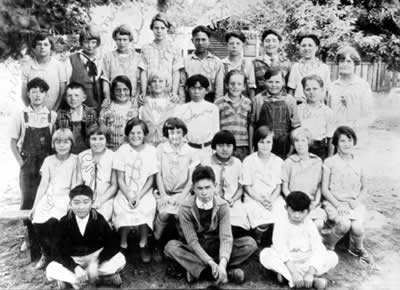 We
walked to and from school. There was a big water pipe that ran across
the creek near the bridge. Sometimes we would go by way of the pipe
and other times we would climb up or come back down the hill by the
bridge. The schoolhouse was on Aldridge where Aldridge Lane Park is
now. We had to walk past (Eng Chung's) apple dryer buildings. (To
the left of the present day Woman's clubhouse.) They were old and
the place looked scary. I didn't like going by there. I don't remember
ever seeing people working there. We
walked to and from school. There was a big water pipe that ran across
the creek near the bridge. Sometimes we would go by way of the pipe
and other times we would climb up or come back down the hill by the
bridge. The schoolhouse was on Aldridge where Aldridge Lane Park is
now. We had to walk past (Eng Chung's) apple dryer buildings. (To
the left of the present day Woman's clubhouse.) They were old and
the place looked scary. I didn't like going by there. I don't remember
ever seeing people working there.
I was in a third and fourth grade class and Ruth Karstedt was my
teacher. One hot day, I decided to roll down my long cotton stockings.
I was scolded by the teacher who saw me. She made me roll them back
up. I was so embarrassed. I didn't know I wasn't supposed to do that.
Games we played were tag, kick the can, hop scotch, red line, jacks,
marbles, hide and seek, and baseball. One time Annie Antonovich accidentally
hit me in the head with a baseball bat. Dorothy Bradley, who was older,
took me to the restroom and put cold paper towels on my head. She
rubbed my forehead so hard that it broke out in a rash. Nothing else
was done. I don't remember if they even told my parents. When I had
the mumps, I was teased about it at school. Ruth Bradley ran around
blabbing about it. Her brother, Paige, used to tease me all the time,
too. I didn't want to go out for recess because I was so bashful.
In the fifth-sixth grade, Clara Munson was my teacher. All I remember
is that we got to watch the eclipse of the sun through a piece of
colored glass.
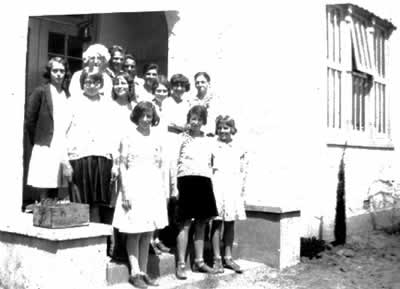 In
the 7th and 8th grades, Elma Bradley was my teacher. By then, we were
in the new school that was built on the same property. I was in the
harmonica band. We went on a few trips. One trip was to San Jose to
play at a radio station. Another time, we rode an old bus to San Francisco
to Golden Gate Park. On the way, I bought a couple of candy bars to
take home to the kids. I had to carry them all day. They were slightly
melted by the end of the trip. On Arbor Day, when I was in the seventh
grade we planted a tree in front of the school. We put mementos into
the hole. Every May 1st, May Day, we would fix little baskets of flowers
and hang them on special people's doorknobs. We always had a May Pole.
We held on to colored streamers coming down from the pole and danced
around it. In eighth grade, I was the editor of our school newspaper
C.U.S. (Corralitos Union School.) I still have a couple of issues of
that. In
the 7th and 8th grades, Elma Bradley was my teacher. By then, we were
in the new school that was built on the same property. I was in the
harmonica band. We went on a few trips. One trip was to San Jose to
play at a radio station. Another time, we rode an old bus to San Francisco
to Golden Gate Park. On the way, I bought a couple of candy bars to
take home to the kids. I had to carry them all day. They were slightly
melted by the end of the trip. On Arbor Day, when I was in the seventh
grade we planted a tree in front of the school. We put mementos into
the hole. Every May 1st, May Day, we would fix little baskets of flowers
and hang them on special people's doorknobs. We always had a May Pole.
We held on to colored streamers coming down from the pole and danced
around it. In eighth grade, I was the editor of our school newspaper
C.U.S. (Corralitos Union School.) I still have a couple of issues of
that.
Each year all the schools in the county would have a playday at Soquel
grammar school (the same one that is there today). My mother always
managed to make me a new dress to wear. When I graduated from eighth
grade, I was salutatorian. My good friend Ella Marie Brodin was valedictorian.
Each one of the graduates received bouquets of flowers. I received
about 8 or 9 beautiful bouquets. My graduation dress and hat were
pale lavender. We had gone to San Jose to buy it. The sales lady gave
me the matching hat at no charge. I felt very grown up. Our graduation
was held at Ceschi Hall. My best friend in grammar school was Annie
Antonovich. We were like sisters. She lived far up Eureka Canyon off
of Rider Road. One summer, we worked up there pitting apricots. We
were just young girls, but Annie had to work hard. She couldn't run
around with us. She didn't go on to high school with me.
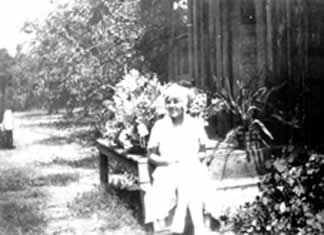
8th grade graduation
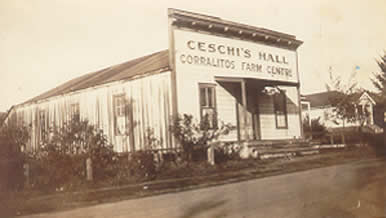
Ceschi Hall, once on Corralitos Road
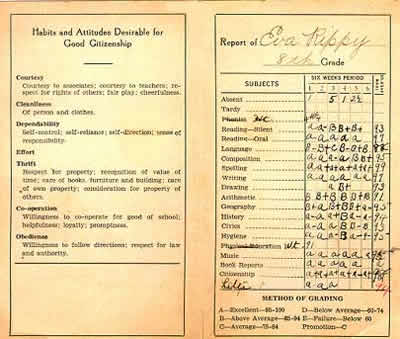
At home every Sunday, my Mom would make a chocolate cake from scratch
and fix a large meal with pot roast, gravy, potatoes, etc. for us
and it seemed like when we were ready to eat some of our relatives
would come to visit. Seems like we always had enough to eat when they
came, though. One of my pet peeves in relation to preparing food was
that I had to mix up the margarine (oleo) by hand. It came white with
a little packet of yellow dye and I had to mix in the color to make
it look like butter. This was only about ten cents a pound. We couldn't
afford to buy real butter. My hands would stay yellow nearly all day.
My mother had certain days that she did things. Monday was washday.
In the early days, she scrubbed clothes on a washboard and then rinsed
them in clean water. She used Fels Naphtha Soap. We always had beans
for dinner on washday. Tuesday was ironing day. Everything was starched
so the clothes had to be dampened before ironing. I helped do that.
Until we got electricity, she used two heavy irons heated on the stove.
The handles had a claw hook to pick up the irons. When one cooled
down, she would get the other one. It took a long time to iron and
wash clothes in those days. Before the weekend, we would clean house
and dust everything in case company came on Saturday or Sunday. I
also helped her by babysitting and taking care of my grandmother,
Emma, when she stayed with us. I remember one time when I went to
Scott's store for my mother to buy $0.25 worth of hamburger. Our cousin,
Glenn Dufer, was the butcher at the time. I knew there was a one-cent
sales tax, so I asked for $0.24 worth of meat so I would have a penny
for the tax. When I gave Glenn my quarter, he gave me a penny change.
I asked about the tax, and he told me there was no tax on food. He
laughed about that, then he gave me a dill pickle for being so smart.
I loved those dill pickles.
We kids always had fun things to do. I liked to read. My favorite
books were Zane Grey and the Wizard of Oz stories. I think I read
them all. Once in a while, if my Mom had ten or fifteen cents she
would buy me a movie magazine. We didn't have a radio to listen to
until I was in 7th or 8th grade. We had swimming holes in the creek
just below our house. I was in 4-H, so every year I got to go to summer
camp at Camp Loma. Once when I was 11 or 12, we went to San Francisco
with Bobo and Uncle Clint. We got on a streetcar, but I don't remember
where we were going. We were sitting behind the conductor and I got
carsick and threw up. Uncle Clint teased me and said it went all over
the conductor. Several weeks later we went to the city again. We started
to get on a streetcar and Uncle Clint said it was the same conductor.
He said he didn't think he would let us ride because he remembered
me (Ha!) We did get to ride, but we sat clear in the back. Everything
went fine, and I still don't think it was the same conductor!
I went to Watsonville High School. We rode a bus driven by Mr. Munson
for a couple of years. Mr. Burgess, who also owned a turkey ranch
(that's another story), took his place. When I started high school
I met the Pybrum family. They had come to Corralitos from Madera and
moved into a new house on Blake. The two oldest boys, Ed and Ray,
hung out with my girlfriends and me. My close friends were Ella Marie
and Connie Brodin, Garland Bradley, Pearl Kryger, and my cousin Dorothy
Diehl. There were other friends, but I mostly did things with those
five. Garland lived up on the cliff above our place. (Near where the
CDF station is today) Her parents had carved out a space on the side
of the hill so they had an outdoor area like a big camping site above
the creek. Garland always wanted me to come over to sleep out there.
I was too afraid to be away from home all night, so I never did.
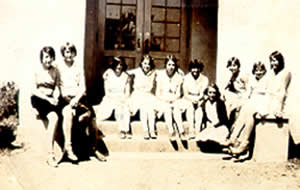
L to R: Garland Bradley, Ella Marie Brodin, Irene Zolezzi, Mildred Berry,
Liddie Mae Gray, Annie Antonovich, Muriel Algeo, Bea Gray, Eva, Pearl
Kryger
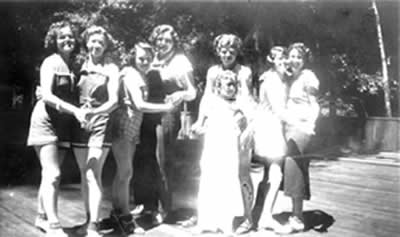
L to R: Grace Bradley, Connie, Olive, Ella Marie Brodin,
Ruth Bradshaw, Gwen Manchester, Thelma Bradshaw, Dorothy Diehl
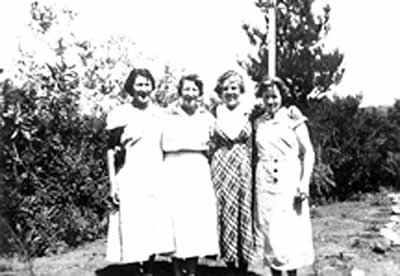
L to R: Dorothy Diehl, Garland Bradley, Eva and Connie Brodin
Often in the evening, the boys would join us and we would skate from
Scott's store (Corralitos Market) to the Five Mile House. We skated
around the 5-mile button that used to be in the middle of the road
at the intersection and skated back. Other times, we just sat on the
sidewalk at the store and talked if we didn't have anything better
to do. The boys pulled pranks all the time. That is were the turkey
ranch comes in. It wasn't beyond them to steal a turkey around Thanksgiving
time. My mother even cooked one of their turkeys. The kids all brought
the rest of the food. The kids hung out at our house most of the time.
One time, I remember eleven boys there visiting my mother more than
anyone else. (I know they weren't visiting me because that was after
the senior picnic at the beach. I was sunburned so badly I could barely
have a sheet around me it hurt so much.) That time it was Ed, Ray,
Vernon Mackleheny, Willis Tindall, Harold Vorheis, Bill Bruin and
some town boys and maybe a couple of cousins, probably. They liked
to talk to my mom. She gave them popcorn and sometimes they played
cards.
Besides school friends always being at our house, our cousins were
often with us, too. Dorothy and her sister Margaret, who had been
with us in Colorado, Bobo and Uncle Clint's daughter, Gwen, and a
few other cousins were there now and then. Ed and Ray's cousins sometimes,
too. My dad worked for the Southern Pacific railroad. He usually worked
nights and slept during the day. There was just a thin wallboard separating
him from all of us. I don't know how he slept. Sometimes, when he
got up to go to work, he would drive some of the kids home first.
During the summer, I usually had a job besides all the fun things
we did. For a while on Saturdays, I worked for two hours doing housework
for Randolph Bradley's wife for $0.25 an hour. (The house is still
on Hames Road across from the entrance to the mobile home park). Ella
Marie and I pitted cots together for Jim Work. We were in 4-H together,
too. We took sewing from Irene Ceschi at her house at 554 Corralitos
Road. Mrs. Ceschi would show us how to do something, but if we couldn't
do it right she would do it herself. While in 4-H, I had swimming
lessons. We were taken to the Boardwalk and used the pool called The
Plunge that used to be in the area where the miniature golf is today.
I loved to swim. One of the instructors told me I had strong arms,
and the way I swam I could be in the Olympics. We always had a water
hole in the creek when the weather got warmer. We would dam up the
stream to make it deep enough to swim. The creek would usually dry
up during the summer.
There is one time Ella Marie and I both remember. Garland was with
us and we were sitting at the store talking when Ed came by driving
his mother's car. He took us for a ride up Hames Road. The road wasn't
paved. It had ruts and potholes. When we were coming down from the
top of the hill by Gramma Roddy's (Catherine Rodrigues) house, the
rear axle broke and the car went off the road. We three girls jumped
out, left Ed, and ran for home. We must of thought we were in big
trouble. We ran down to the store. Ella Marie lived in the house at
the corner at that time. Garland and I continued to her house up the
road. Her mother was very mad. I guess Garland wasn't suppose to ride
in a boy's car. My mother just grinned when I told her. (Ella Marie
and I are friends to this day. She e-mails me often and comes to visit
from her home in Saratoga.)
My Mom knew Ed. He spent a lot of his free time at our house. He
used to do things like borrow money from her to take me to a movie.
He and I saw our first "talkie" movie together Min and Bill
starring Marie Dressler and Wallace Beery. She won an Academy Award
for it. Usually, when Ed and I went on a date it was with the gang
or to a movie and Brownie's for a soda. (Some will remember where
Landis's was in Freedom. That used to be Brownie's.) We used to get
a free dish each time we went to the movies. I don't know how many
we collected, but if you went often enough you could get a set. You
could do the same thing with Duz soap. When soap started being sold
in granular form there would be a dish inside the box.
|
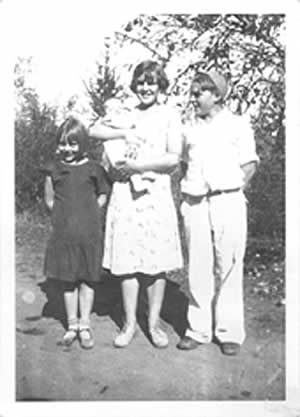
The Rippy children
|
In September when I was fifteen, my sister, Joyce, was born. All
my friends and I were so much older but we couldn't wait to see
her. The next day after she was born, I brought all my gang to the
house. Everyone wanted to hold her. She was a real blessing to our
family because when she was 1 years old my brother, Leslie, became
ill and passed away. Doctors made house calls then. One day, three
doctors came and had a consultation with my mom and dad. Leslie
had to be taken to a hospital in San Francisco to be treated for
a severe ear infection involving the mastoid area. His death was
very hard on all of us. Leslie had made friends with everyone, old
or young, and everyone liked him. His illness effected the whole
community. Elma Bradley even let him drive her car once. He was
a great teaser. He used to drive us crazy with his teasing. One
day when we were doing dishes, he made me so mad I threw dishwater
all over him. I almost had to run to Watsonville to get away from
him. He was so mad. One year, he and I went alone to Pagosa Springs
on the train. We got free passes because our dad worked for the
railroad. On the train, Leslie worried me because he made friends
with every one he met. Once when the train was stopped so everyone
could get out to look at the Grand Canyon, I couldn't find him.
He didn't come back to our seat. The train left and I was so scared.
I thought that I had lost him. He had met someone and, while talking,
got into the next car.
|
|
Also, when I was sixteen, the Corralitos Grange was organized.
Meetings were held at the schoolhouse. Then, we had all our activities
at the schoolhouse or at Ceschi Hall, which was just down the road
from the store. My family was involved with the Grange. I had a
lot of fun helping with the fundraisers to build the new hall next
to the school property. Uncle Clint was the first master there.
I was seventeen when I joined. I was in the drill team and got to
wear pretty formals. I also held the office of Ceres. It was my
job to carry in the American flag at the beginning of the meetings.
When I was nineteen, the Grange sponsored me in The Goddess of Liberty
contest in Watsonville during the 4th of July celebration. Winning
was based on who could sell the most tickets rather than on beauty
or talent. We did have to walk across stage in evening dresses,
though. We went to luncheons, articles were written about us in
the newspaper, and we were in the parade. I didn't win, but it was
sure fun. I still have those newspaper clippings.
|
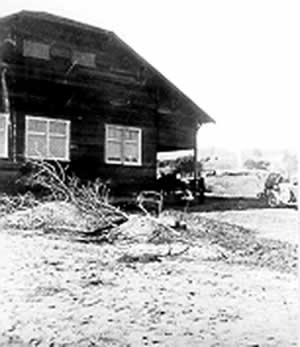
Corralitos Grange Hall 1934
|
Another memory I have is of getting my first permanent. The gal hooked
me up to a machine that had about 10 clamps connected to electricity
to heat. She then would part your hair in sections and put one of
these hot clamps on each section. It got a little warm and your hair
came out rather frizzy and dry but it was a perm, as such. When we
did get our hair styled, it was called a Marcel. Usually, I wore a
bob and my mother would cut my hair. Two things my mother hated were
walking on spilt sugar and picking up bobby pins from the floor. With
three girls around the house, that was common. As for nail polish,
our Dad would hit the ceiling if we even opened a bottle near him.
The odor made him sick.
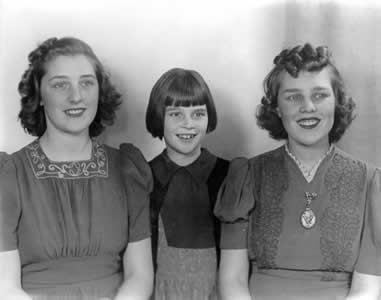
Norma, Joyce and Eva
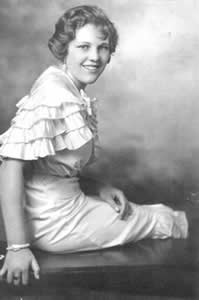
Eva dressed for the prom
After high school graduation, I went to Hartnell College in Salinas
for one semester. I had a chance to work at the telephone company,
and that was what I wanted to do. We didn't have a phone, so when
I applied at Pacific Telephone and Telegraph, I asked Elma Bradley
if I could use hers for a reference number in case they called me.
She was one of the few people in Corralitos that had a phone at the
time. She lived between the Free Methodist Church and us. Then we
lived in the house at 109 Brown's Valley. When they did call me to
work, she came down to the house to tell me. When we got a phone,
our number was 8y5. It was a party line with five other families.
When the operator rang 5 short rings it was our phone.
I worked for Pacific Tel. and Tel. for six years. In the next few
years, I went to work for the Southern Pacific Railroad in Watsonville
as a PBX switchboard operator and connected with my school friend
Annie Antonovich again. We continued to be best friends until her
passing.
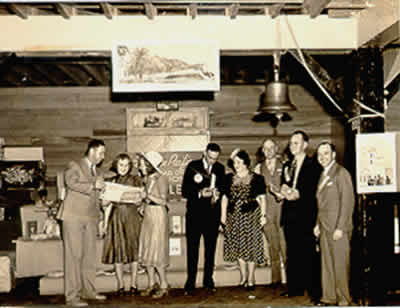
Eva with Ruthie Brodin at a Southern Pacific booth at the auditorium
once on Second Street in Watsonville.
Others in photo: Mr. Tucker, E.K.Springer, Mrs. Lee Williams, W.E. Luidsten,
H.L. Sopher (engineer), and Ed Duebner
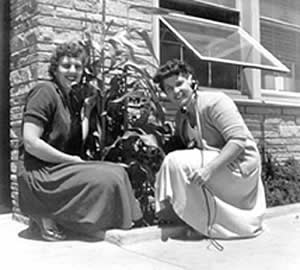
Eva and Ann Antonovich Clay at Watsonville depot
I didn't date very many fellows. My mother made me go on a date with
Phillip Benson once. His mother took us to the Boardwalk. I think
I said two words to him the entire time. A boy named Don Herda used
to come to our house with his folks. He had red hair and freckles
and he really liked to tease me. I usually hid under the bed. He gave
me a string of red beads once. He would sing to me. "Just Eva
and me and baby makes three…." I really hated that! I was
so bashful and shy, my mother had to make me go places. I remember
going to a dance at Ceschi Hall, but I don't remember who I was with.
I think I went with my girlfriends. I didn't dance. There were older
boys there, Fred Frederick, Eugene and Eddie Spain. Eddie had the
back seat wired in his car so that when a person sat down they were
shocked. Garland and I got into the back seat only once!
All through high school, Ed was mostly my boyfriend. After high school,
I dated Gordon Shaw. He was a dreamboat. I still have photos of him.
I was still dating Ed most of the time, though. He went to Hartnell
and then worked at Fort Ord. Eventually, I married him. We settled
in Corralitos. At first, for a short while, we lived with my parents.
They had moved to 547 Corralitos Road. We rented the house at 3 Blake
before we bought our apple ranch at 354 Hames Road from the Rodrigues
family.
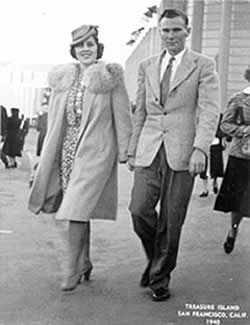
Ed and Eva on a date
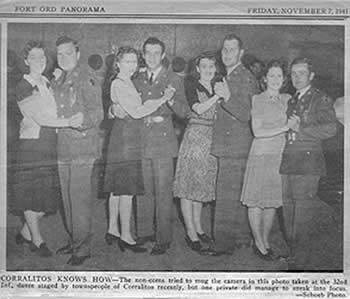
A dance at the Grange hall.
L to R: Norma Rippy, Connie Brodin, Eva, Patty Howe -others not identified
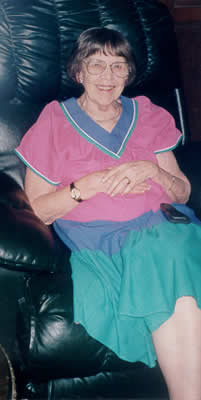 A
few years after we were married, Judy was born. A few years later,
her brother John was born. Then, we lived at Route 5 Box 610 (46 Blake) in the same house Ed's mother had bought when his family moved here.
Actually, I've lived in Corralitos in about ten different places.
Most all of the houses (some remodeled) are still here, too, just
like me. A
few years after we were married, Judy was born. A few years later,
her brother John was born. Then, we lived at Route 5 Box 610 (46 Blake) in the same house Ed's mother had bought when his family moved here.
Actually, I've lived in Corralitos in about ten different places.
Most all of the houses (some remodeled) are still here, too, just
like me.
|
